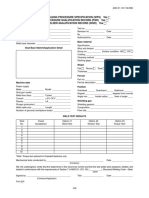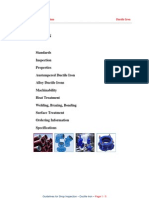0 ratings0% found this document useful (0 votes)
80 viewsUW Sling Inspection Check List
This document is a checklist for inspecting slings used for lifting at the University of Washington. It includes sections to record the sling identification details like location, manufacturer, serial number, and working load limit. The checklist then lists potential damage types to examine for each component, including chains, hooks, master links, synthetic fiber webs, and end fittings. Inspectors check for issues like worn or deformed links, throat opening exceeding specifications, cuts or abrasions exceeding web thickness, and cracks or distortions.
Uploaded by
Engr Arfan Ali DhamrahoCopyright
© © All Rights Reserved
Available Formats
Download as PDF, TXT or read online on Scribd
0 ratings0% found this document useful (0 votes)
80 viewsUW Sling Inspection Check List
This document is a checklist for inspecting slings used for lifting at the University of Washington. It includes sections to record the sling identification details like location, manufacturer, serial number, and working load limit. The checklist then lists potential damage types to examine for each component, including chains, hooks, master links, synthetic fiber webs, and end fittings. Inspectors check for issues like worn or deformed links, throat opening exceeding specifications, cuts or abrasions exceeding web thickness, and cracks or distortions.
Uploaded by
Engr Arfan Ali DhamrahoCopyright
© © All Rights Reserved
Available Formats
Download as PDF, TXT or read online on Scribd
You are on page 1/ 1
UW Sling Inspection Check list
Sling Identification
Location__________________ Department _______________ Date____________
Manufacturer _____________________ Serial Number __________________
Working Load Limit ________________ Reach ________________
Sling Type _______________ Inspector _________________
Damage Inspection Y N Comments
Chain
1. Reach Measurement (within manufactures
specification)
2. Worn Links
3. Deformed links
4. Cracked Links
5. Corroded Links
Hook
1. Deformation (exceeding 10 degrees)
2. Throat Opening (exceeding 15 % of original)
3. Wear (exceeding 10 % of original)
4. Cracks of Nicks
Master Link
long Axis (within manufactures specifications)
Short Axis (within manufactures specifications)
Wear (exceeding 10 % of original)
Cracks or Nicks
Synthetic Fibre Web
1. Edge Cut (exceeds web thickness)
2. Abrasion (exceeds 15% of web thickness)
3. Thread Damage
4. Stitches Damaged
5. Charged
6. Corroded (acid or base)
7. Melted
End Fitting Synthetic Fibre Web
1. Pitted
2. Cracked
3. Distorted
4. Broken
You might also like
- Hourglass Workout Program by Luisagiuliet 276% (21)Hourglass Workout Program by Luisagiuliet 251 pages
- The Hold Me Tight Workbook - Dr. Sue Johnson100% (16)The Hold Me Tight Workbook - Dr. Sue Johnson187 pages
- Read People Like A Book by Patrick King-Edited62% (66)Read People Like A Book by Patrick King-Edited12 pages
- Livingood, Blake - Livingood Daily Your 21-Day Guide To Experience Real Health77% (13)Livingood, Blake - Livingood Daily Your 21-Day Guide To Experience Real Health260 pages
- COSMIC CONSCIOUSNESS OF HUMANITY - PROBLEMS OF NEW COSMOGONY (V.P.Kaznacheev,. Л. V. Trofimov.)94% (212)COSMIC CONSCIOUSNESS OF HUMANITY - PROBLEMS OF NEW COSMOGONY (V.P.Kaznacheev,. Л. V. Trofimov.)212 pages
- Donald Trump & Jeffrey Epstein Rape Lawsuit and Affidavits83% (1016)Donald Trump & Jeffrey Epstein Rape Lawsuit and Affidavits13 pages
- The 36 Questions That Lead To Love - The New York Times94% (34)The 36 Questions That Lead To Love - The New York Times3 pages
- The 36 Questions That Lead To Love - The New York Times95% (21)The 36 Questions That Lead To Love - The New York Times3 pages
- Jeffrey Epstein39s Little Black Book Unredacted PDF75% (12)Jeffrey Epstein39s Little Black Book Unredacted PDF95 pages
- The 4 Hour Workweek, Expanded and Updated by Timothy Ferriss - Excerpt23% (954)The 4 Hour Workweek, Expanded and Updated by Timothy Ferriss - Excerpt38 pages
- Vibration Basics and Machine Reliability Simplified : A Practical Guide to Vibration AnalysisFrom EverandVibration Basics and Machine Reliability Simplified : A Practical Guide to Vibration Analysis4/5 (2)
- Figure 1-Sample Welding Procedure Specification FormNo ratings yetFigure 1-Sample Welding Procedure Specification Form2 pages
- Rigging Study & Lifting Plan For Oil Storage Tank at Naimat100% (4)Rigging Study & Lifting Plan For Oil Storage Tank at Naimat15 pages
- Pre-Use Inspection - Rigging Equipment / Asme B30.9: Company: Rigger's Name: Date0% (1)Pre-Use Inspection - Rigging Equipment / Asme B30.9: Company: Rigger's Name: Date1 page
- Lifting Bars and Spreaders Load Test Report: 6.0/12911e051.pdf 1 (07/2007)No ratings yetLifting Bars and Spreaders Load Test Report: 6.0/12911e051.pdf 1 (07/2007)1 page
- B2.1 B2.1M 2014 Amd1 Procedure Qualification Record PQR PDFNo ratings yetB2.1 B2.1M 2014 Amd1 Procedure Qualification Record PQR PDF2 pages
- Aws Form E-9 Stud Welding Procedure Specification (WPS) or Procedure Qualification Record (PQR) or Welder Qualification Record (WQR) 000 PDFNo ratings yetAws Form E-9 Stud Welding Procedure Specification (WPS) or Procedure Qualification Record (PQR) or Welder Qualification Record (WQR) 000 PDF1 page
- B2.1 B2.1M 2014 AMD1 Stud Welding WPS PQR or WQR FormNo ratings yetB2.1 B2.1M 2014 AMD1 Stud Welding WPS PQR or WQR Form1 page
- Form O-5-Welder and Welding Operator Qualification RecordNo ratings yetForm O-5-Welder and Welding Operator Qualification Record1 page
- Form L-5-Welder and Welding Operator Qualification RecordNo ratings yetForm L-5-Welder and Welding Operator Qualification Record1 page
- LAMP. 4. 4. Draft Lifting Plan ProcedureNo ratings yetLAMP. 4. 4. Draft Lifting Plan Procedure12 pages
- F3 Lifting Equipment Inspection Report Rev. 1No ratings yetF3 Lifting Equipment Inspection Report Rev. 11 page
- Winch Machine Daily Inspection ChecklistNo ratings yetWinch Machine Daily Inspection Checklist1 page
- Welding Procedure Specification (WPS) Yes PREQUALIFIED - Qualified by Testing - or Procedure Qualification Records (PQR) Yes100% (1)Welding Procedure Specification (WPS) Yes PREQUALIFIED - Qualified by Testing - or Procedure Qualification Records (PQR) Yes4 pages
- Welder Qualification Test Log: Engineering Standards Manual OST220-03-01-ESM Chapter 13, Welding100% (1)Welder Qualification Test Log: Engineering Standards Manual OST220-03-01-ESM Chapter 13, Welding1 page
- Welder or Welding Operator Qualification Test Record: Annex M AWS D1.6/D1.6M:2007No ratings yetWelder or Welding Operator Qualification Test Record: Annex M AWS D1.6/D1.6M:20071 page
- Oc and SC Tests On A Single-Phase Transformer: Experiment No. 1No ratings yetOc and SC Tests On A Single-Phase Transformer: Experiment No. 15 pages
- Bobcat_Weekly_Maintenance_Checklist_WeeklyNo ratings yetBobcat_Weekly_Maintenance_Checklist_Weekly4 pages
- Report of Magnetic-Particle Examination of WeldsNo ratings yetReport of Magnetic-Particle Examination of Welds1 page
- Sample Report of Magnetic-Particle Examination of WeldsNo ratings yetSample Report of Magnetic-Particle Examination of Welds1 page
- Cranes Today March 2004 What To Look ForNo ratings yetCranes Today March 2004 What To Look For3 pages
- Form 6 - Power CKT BKR - Services Dept Manual - Rev 0 Nov 5, 2012No ratings yetForm 6 - Power CKT BKR - Services Dept Manual - Rev 0 Nov 5, 20122 pages
- JLG Inspection Checklist: 1400 East Columbia Street Evansville, IN 47711 812-422-3340No ratings yetJLG Inspection Checklist: 1400 East Columbia Street Evansville, IN 47711 812-422-33402 pages
- Practical Approaches to Method Validation and Essential Instrument QualificationFrom EverandPractical Approaches to Method Validation and Essential Instrument QualificationNo ratings yet
- ISA Certified Control Systems Technician (CCST): Certification Exam Prep: 500 Practice Exam Questions and ExplanationsFrom EverandISA Certified Control Systems Technician (CCST): Certification Exam Prep: 500 Practice Exam Questions and ExplanationsNo ratings yet
- Gmail - Application For Electricity Meter ChangeNo ratings yetGmail - Application For Electricity Meter Change1 page
- Aim of Procedure: Inspection of Lifting Equipment100% (1)Aim of Procedure: Inspection of Lifting Equipment11 pages
- Common Problems With Rigging Equipment: #1 - Missing or Illegible Identification/Tags On Rigging EquipmentNo ratings yetCommon Problems With Rigging Equipment: #1 - Missing or Illegible Identification/Tags On Rigging Equipment11 pages
- Magnetism III: Magnetic Ordering: Physics 355No ratings yetMagnetism III: Magnetic Ordering: Physics 35527 pages
- Magnetism III: Magnetic Ordering: Physics 355No ratings yetMagnetism III: Magnetic Ordering: Physics 35527 pages
- Zyglo Liquid Fluorescent Penetrant Inspection ApplicationsNo ratings yetZyglo Liquid Fluorescent Penetrant Inspection Applications1 page
- Magnaglo Carrier II Oil Is Designed To Promote Enhanced Magnetic Particle Mobility and SuspensionNo ratings yetMagnaglo Carrier II Oil Is Designed To Promote Enhanced Magnetic Particle Mobility and Suspension1 page
- Zyglo ZE-4B Is A Lipophilic Emulsifier. It Can Be Used in Open Tanks Due To Its Low Volatility and High Flash Point. ZE-4B Is Non-CorrosiveNo ratings yetZyglo ZE-4B Is A Lipophilic Emulsifier. It Can Be Used in Open Tanks Due To Its Low Volatility and High Flash Point. ZE-4B Is Non-Corrosive2 pages
- Magnaflux Crack Comparators Assist in Measuring The Size of LPI IndicationsNo ratings yetMagnaflux Crack Comparators Assist in Measuring The Size of LPI Indications3 pages
- Our Zyglo ZA-70 Portable (Aerosol) Fluorescent Kit Offers Improved Sensitivity Over Our Spotcheck Visible Red Dye Test KitNo ratings yetOur Zyglo ZA-70 Portable (Aerosol) Fluorescent Kit Offers Improved Sensitivity Over Our Spotcheck Visible Red Dye Test Kit1 page
- Easily and Accurately Measure Shot Time, The Quick Break Status, and Amperage of MPI Equipment With Magnaflux Monitoring DevicesNo ratings yetEasily and Accurately Measure Shot Time, The Quick Break Status, and Amperage of MPI Equipment With Magnaflux Monitoring Devices2 pages
- Amazon.com Opposuits Party Suits for Teen Boys -…No ratings yetAmazon.com Opposuits Party Suits for Teen Boys -…1 page
- Cruise Training Manual 2021 3C (2021.05.04) PDFNo ratings yetCruise Training Manual 2021 3C (2021.05.04) PDF46 pages
- Student Name: Maywa Cynthia Signature: DateNo ratings yetStudent Name: Maywa Cynthia Signature: Date24 pages






















































































































